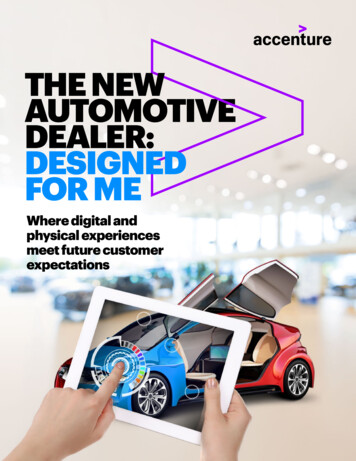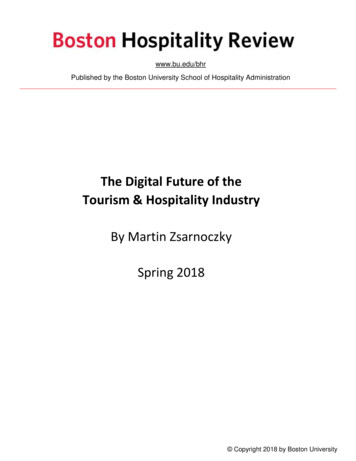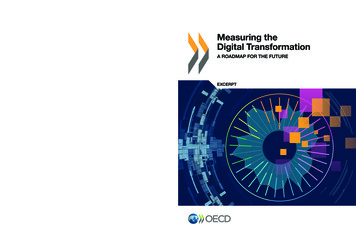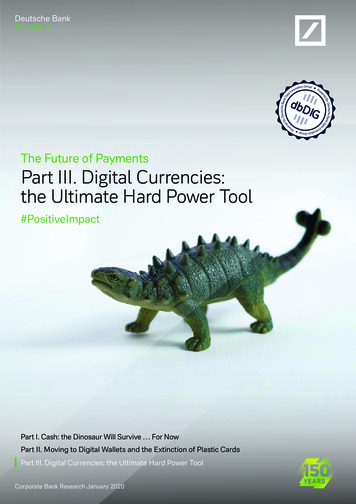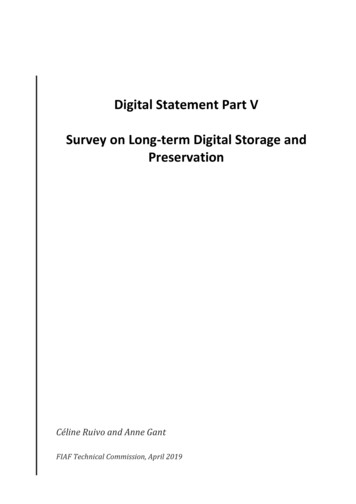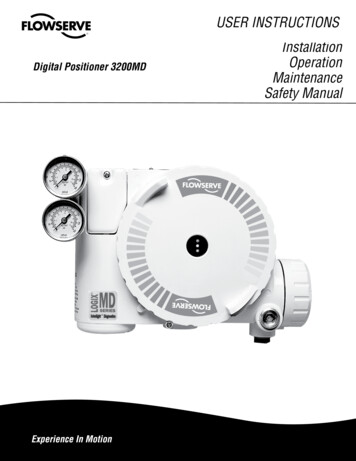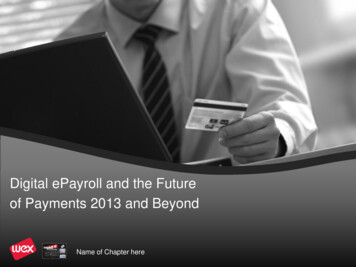
Transcription
Digital ePayroll and the Futureof Payments 2013 and BeyondName of Chapter here
Agenda1. Audience Survey2. Making the Case for Prepaid3. Users of Prepaid Cards4. Are Prepaid cards a viable alternative to a bank account?5. Reasons Why Paycards Don’t Achieve Company Goals6. Questions/Comments
How many more years willCASH EXIST?How about the Penny, All Coins, Dollaror All Paper Money?
How many of you NEVERproduce a PAPER CHECKout of your payroll office?
WHY?Your explanations ARE VALID!
How many of you NEVERproduce a PAPER PAYSTUB out of your payrolloffice?
WHY?Your explanations ARE VALID!
Could the Underserved Segment be the CAUSE?821,000 more U.S. households have become unbanked since the first survey in2009, representing a 0.6 % point increaseOther key findings of the survey include: 8.2 % of U.S. households are unbanked with approximately 17 million adultslive in unbanked households. 20.1 % of U.S. households are underbanked. This represents 1 in 5households, or 24 million households with 51 million adults. 29.3 % of households do not have a savings account, while about 10 % donot have a checking account. 25% of households have used at least one alternative financial service (AFS),such as non-bank check cashing or payday loans in the past year, andalmost 1 in 10 households have used two or more types of AFS products orservices. In all, 12 percent of households used an AFS in the past 30 days, including 4in 10 unbanked and underbanked households.
Could Management be the CAUSE?1 Employee Huge SavingsBy switching to Direct Deposit, an individual employee, paid everytwo weeks, can: Save a pound of paper per year Avoid the release of 4 gallons ofwastewater into the environment Avoid the release of 1 pound ofgreenhouse gases into theatmosphere. This amount ofgreenhouse gases is the equivalent of:– 4 miles not driven in your car– ½ square foot of forest preserved
Making the Case forPrepaid
US Prepaid open loop expected to reach 442B2017 Projected US Prepaid Open Loop by Vertical ( Billions)Source: “BCG Prepaid Market Sizing Study”, May 2010. Research commissioned by MasterCard. Payroll dominates the commercial segment General use is expected to have the largest potential in theconsumer vertical
Why Are Prepaid Cards a Payroll Option Network branded prepaid cards provide consumers, businessesand governments with the efficiency, security and flexibility of directdeposit. Most prepaid cards benefit from broad acceptance, as they can beused anywhere the card brand (Amex, Discover, MasterCard,Visa) credit/debit card is accepted. May provide a point of FREE CASH DELIVERY and EMPLOYEEACCESS for their payroll
Who Uses Prepaid Cards Millions of Americans use network branded prepaid cards for thechoice and protection they provide Much of today’s economy REQUIRES ELECTRONIC PAYMENT Who would not otherwise have a way to participate–Employees who are seeking a non-credit payment tool, that helps theusers control their budget and offer many of the same fraud and lossprotections.–Funds are loaded by employers for payroll, rewards/incentives and bygovernment for benefits–Employees/parents of college-aged students who want a safe andsecure way to give money without the risk of running up debt
How Prepaid Cards Work For the consumer, the cards work like traditional debit/credit cards. A consumer can take a prepaid card to their favorite store oronline retailer and use it just like they would a regular credit ordebit card. They can also use the card to pay bills, book airlinetickets, rent a car, buy dinner, etc. Many cards allow consumers to take cash out at ATMs. The cards offer the same fraud and loss protections as any creditor debit card, but with one big difference: the funds on the card arepre-paid (by the consumer, business or government on theirbehalf). Prepaid cards help the consumer control their budget and avoidinterest charges, running up debt and overdraft fees.
Who is the user for PrepaidCards?Is it YOU?
Is the Prepaid Card a True Employee Benefit? People might be surprised to learn that so many prepaid card customersactually have bank accounts.Ron Hynes, Executive Vice President of Global Prepaid Solutions atMasterCard : It's an emerging phenomenon. I don't think consumerbehavior has changed, necessarily. Consumers have always beeninterested in control, budgeting, segmented spending, etc. In fact, I can goback forty years and remember my mother with her Christmas Clubaccount. That was a very segmented system, and she was systematic inhow she put money away so that when the holidays came she had moneyto go out and spend. So I don't think the consumer dynamic has changed.What consumers are beginning to understand is the ease with which theycan accomplish some of that planned spending through prepaid productsand offerings.
Do Any of These Cases Fit In With Your Company?“Cashing my check every week used to cost me a lot in fees and charges and Iwasted a lot of time waiting in line. Now my pay is automatically deposited on aprepaid card. I get free purchases and free cash back, free bill pay and I don’thave to stand in line anymore. It means freedom to me and I have a card thatlooks and works just like my friends who have checking account debit cards” –Diane, Payroll Card“I love using my reloadable prepaid card because it's convenient, safe and allowsme to spend only the money that's on the card. I use it to buy everything from gasand groceries, and even pay bills for phone or utilities. When I go out to dinnerwith friends and we split the bill, I can use my prepaid card just like a bank debitcard or credit card” - Chris, Reloadable Card“My daughter is 15 and I want to teach her how to manage money. Instead of agiving her cash or a debit card, I give her a reloadable prepaid card, which I canreload with her allowance and other money received from babysitting or as gifts.Knowing her card is protected if it lost or stolen gives me piece of mind. I also likethe fact that she can't overspend” - Claudia, General Purpose Reloadable Card for TeensNBPCA
Are Prepaid Cards a ViableAlternative to a BankAccount?
Prepaid Card Costs vs. TraditionalBank Account Costs 2009For the Consumers Union transaction pattern, general purposereloadable (GPR) prepaid card users’ costs range from 76 to 380annually.The reloadable prepaid card costs would decrease after the first year by theamount of the activation fee. With the current turnover of these cards, manyconsumers will incur these costs unless they are payroll cards; therefore,maintaining the same card will reduce the annual costs.Bank customers pay from 218 to 314 annually for a basic checkingaccount with the same common usage patterns referenced above.It should be noted that these costs include five overdrafts per year, a 17%reduction from last year. However, recent analyses indicate that many moreconsumers than anticipated are opting in for the debit card overdraftcoverage. Also, Bretton Woods’ 2009 study of overdrafts indicated thatactive household users of overdrafts incur more than four overdrafts permonth, or 51 per year.
What about FREE Checking? OrCheck Cashing?To be consistent with the reloadable prepaid card comparison, if bankaccount customers meet the criteria (e.g. 1,500 average balance,direct deposit or electronic access only) to minimize fees, thesecustomers would pay 127 to 250 annually. However, given thatthe average deposit is 350 twice per month, the likelihood ofmaintaining a 1,500 average balance is negligible.Check cashers and cash users pay 140 to over 720 annually.Walmart is at the low end of the scale and the company is aformidable competitor given its presence in the United States. Themore expensive end of the scale includes Western Union and AceCash Express. While most consumers will find a lower cost alternativethan this mix, we believe it is important to see the possibility of thehigher costs to consumers.
Costs Comparison – Consumers UnionTransaction Pattern
The shifting cost model is resulting in anincreased acceptance of prepaid cardsThe early users of branded prepaid cards tended to be theunderbanked. With new fee structures on basic checking accounts andfewer branch offices in low to middle income communities, theunderbanked face more obstacles to mainstream banking. Appropriateeducation to these consumers will allow reloadable prepaid cards to bea safe and cost-effective means of conducting basic financialtransactions.Also, today more mainstream banking consumers are adoptingbranded prepaid cards for unique purposes like budgeting and fundingthe pending needs of children, students and parents without the risk ofoverdraft. The costs are typically lower than alternative paymentmethods and the convenience and security of branded prepaid cardsare on a par with checking accounts and are far superior to cash.
I heard that prepaid cards are unregulatedand I would be safer carrying a debit orcredit card. Is this true? All network branded prepaid cards are issued by highly regulatedfinancial institutions and are subject to examination, review andoversight by federal agencies such as the Federal Reserve Board,the United States Treasury, the Office of Thrift Supervision and/orthe Office of the Comptroller of the Currency. They are processedthrough an online system that tracks and records every use: boththe cardholder purchase and the merchant where the purchase istaking place. Network branded prepaid cards are subject to the same zeroliability protection offered by the brand mark on the card(American Express, Discover, MasterCard or Visa). If a prepaidcard is lost, stolen or used for purchases without authorization,report it to the customer service number immediately and the cardmay be reissued and the funds replaced.
But My Employees Like toCash Checks!
Payroll Card Compliance MapState Sized by Population Size
ATM Networks
Prepaid Card SatisfactionCardholders: Who are they really? Dispelling the myths indicates thatprepaid cards are not just a tool for the underbanked. 43% are Gen Y’ers 1/3 earn more than 45,000 34% have a college degree or higher There is high consumer satisfactionQ. How satisfied are you with using a prepaid debit card?(n 250)Very: It’s as helpful as Ithought it would be44%Not: It’s not particularly helpful6%Extremely: It’s even morehelpful than I thought itwould be29%Somewhat: It’s helpful, butnot as much as I’d expected22%GPR Cardholders: Who are they really? Dispelling the myths., The Aite Group, March, 2012. Aite Group’s Survey of 500 U.S. consumers whouse alternative financial services, Q1, 2011
The National Urban League Reason to use a prepaid cardWhat Prepaid Users Liked MostCan't overspend/overdraftEasier and Safer than carrying cashEasier to pay my billsCan have direct depositCheaper than using a check casherLike having a card with a Discover/Visa/Saves me timeCheaper than a bank accountEasier to manage my money than what IOther
Direct Deposit Will LeadMy Employees to FreeBanking
PAY CARD ANALYSISAUGUST, 2011BRETTON WOODS, INC.
PIN vs Signature Transaction ratioThe PIN versus Signature transaction ratio for pay cards is 56% for Signatureand 44% for PIN transaction compared to the 2010 Federal Reserve PaymentsStudy of 62% for Signature and 38% for PIN:billions14.8%25.037.9Debit )20062009On a percentage basis, the cost of the pay card to the pay card consumer isonly 1% of their total earnings. This is much more favorable than otheravailable options.
Q. For what do you use a prepaid debit card most frequently?(n 250)40%27%24%9%At stores andrestaurantsFor onlineshoppingTo pay billsSource: Aite Group’s survey of 500 U.S. consumers who use alternative financial services, Q1 2011At ATMs
Reasons Why PaycardsDon’t Achieve CompanyGoals
Hurdles to Successful Payroll Card Adoptionand EnrollmentPayrollCard
Inadequate Employee TrainingClient training is Critical!A PayCard company without a STRONG clienteducation and training system is WEAK.PayCard Providers must offer PayCard Education Training on Use An Employee SatisfactionguidePayCard programs with inadequate client training will haveLOW satisfaction and program success will be MINIMAL.
Reasons Why Paycards Don’t AchieveCompany GoalsOverdrafts: What to look for?Some payroll debit cards can be overdrawn and the card programscharge “Overlimit or NSF fees” The primary reason the unbanked are unbanked is largely due topast exposure to and their desire to avoid overdraft fees. Why put your employees back in the same position. If overdraft is possible – what is the opt-in process?Look for Instant Issue Branded-Visa, MasterCard, Discover: Be aware that some paycards offer an upgraded, embossed VISAor MasterCard branded card for a fee. The unbranded instant issue Card is simply an ATM card. This ATM only card brings into question an employee’s ability togain access to their “pay to the penny”. Access to “pay to thepenny” is a requirement in many states for a paycard to be legallycompliant to the “letter” of the law.
Reasons Why Paycards Don’t Achieve CompanyGoalsEvaluate the Issuing Bank: The issuing bank is IMPORTANT!, You should evaluate if the relationship isnew to the paycard provider. If it is new, why? Is it due to a Bank Failure? With the environment today, it is important to askthe question. Take Caution with a bank that has been through FDIC acquisition dueto the FDIC Acquiring Bank being new to the prepaid business. This represents future risk to your cardholders and additional work foryour company. Prepaid issuing banks are specialized and require depth of knowledgefor BSA and AML program underwriting. Without experience or understanding the NEW bank may simplydiscontinue their participation in the card program. Don’t assume that a major bank houses the accounts and system – mostoutsource the entire system.
Reasons Why Paycards Don’t AchieveCompany GoalsWhat is Card linking?:Historically lost and stolen cards can be a huge issue for acompany with unbanked workers. Not all paycard providers handle the process of lost orstolen card replacement the same way and they mayinevitably lead to a negative cardholder experience. Be aware that employees may not have access to allfeatures of program with a PIN only replacement card,there may be a period of time without account access andtransfer fees to bring over balances.
Reasons Why Paycards Don’t AchieveCompany GoalsYou want reports! Lots and lots of reports! Beware – the requested report may be a violation of the GrammLeach-Bliley Act. While there are many reports available to paycard clients, you don’twant to access to information on employee spend.o This is for one very important reason The Account is Privateand Owned by the Employee. Having access to this “spend”information puts your company and employees at risk. Select a paycard team that stays current with this dynamic area ofregulation through participation in the Visa-sponsored PaycardRoundtable, which is a group focused on creating a legislativeenvironment favorable to paycards and The Network BrandedPrepaid Card Association ’ s (NBPCA) Government RelationsCommittee.
If you have any questions please contact rapid! PayCard:Brian Slowik(727) 828-1635Brian Slowik@wrightexpress.com
If you have any questions please contact rapid! PayCard:Chris Ruppel(727) 828-1634Chris.Ruppel@wexinc.com
If you have any questions please contact rapid! PayCard:Leeann Uridge(630) 953-9331Leann.Uridge@wexinc.com
If you have any questions please contact rapid! PayCard:Dallas Wilfong(813) 344-3139Dallas.Wilfong@wexinc.com
Review of PrepaidTerms, Definitions andResources
What defines “Open Loop”?There are two general categories of Prepaid Cards: Retailer Branded(often called Closed Loop), typically issued by a Retailer and redeemableonly at the issuing Retailer and Network Branded (often called OpenLoop), typically redeemable wherever the Card Brand is accepted.Some consider Restricted Authorization Network (RAN) Cards a thirdcategory of Prepaid Cards. These cards typically are accepted forpayment at multiple retailers (such as those in a mall or a certaingeographic location) but are not universally accepted like NetworkBranded Prepaid Cards. Often, RAN Cards “run” on the rails of the CardBrands, meaning they make use of the Card Brand processing andfinancial settlement infrastructure but do not include a Card BrandAcceptance Mark.Prepaid Cards may be Consumer Funded, Corporate Funded orGovernment Funded.
What Defines “Closed-Loop”?One of the two major categories of Prepaid Cards. Closed-LoopPrepaid Cards are typically issued by a Retailer and redeemable onlyat the issuing Retailer (in a store and/or online). Characteristics ofClosed-Loop Prepaid Cards include: Plastic version of a paper gift certificate Issuer is the Retailer that accepts the card Cards useable only at the issuing Retailer ’ s locations (whichsometimes includes the Retailer’s Website) or at approved multiple,affiliated merchant locations, such as Merchants owned by the sameparent company Usually non-reloadable, but some permit reloads Runs on the Retailer’s POS system (Clerks know the outstandingbalance and often can provide a receipt with the remaining balance toCardholders)
What is a Payroll CardA Prepaid Card that is directly or indirectly established through anemployer and to which electronic fund transfers of the Cardholder’swages, salary or other employee compensation (such as commissions)are made on a recurring basis, whether the account is operated ormanaged by the employer, a third-party payroll processor, a depositoryinstitution or any other person.Payroll Cards are a smart and safe alternative to checks and directdeposit for unbanked employees, who use the cards to access cash,pay bills and make purchases. Payroll Cards also are useful for bankedemployees in a variety of situations such as per diem workers.
Customer Identification Program (CIP) (U.S.)In the United States, an established process used by financial institutions toestablish a reasonable belief that they know the true identity of their customers.A CIP must include new account opening procedures that specify the identifyinginformation (such as name, address, date of birth, taxpayer ID number or SocialSecurity Number for individuals, or other government-issued ID) that will beobtained from each customer and reasonable and practical risk-based proceduresfor verifying their identities.CIP is required by the USA PATRIOT Act. The law, implemented by regulation in2003, requires financial institutions to develop a CIP appropriate to the size andtype of its business. The CIP must be incorporated into the financial institution’sBSA/AML compliance program, which is subject to approval by the financialinstitution’s board of directors.See http://www.nbpca.com/en/Government-Affairs.aspx for the NBPCA ’ sRecommended Practices document.
Debit CardA plastic card, embossed or printed with the Cardholder’s name,which is used by the Cardholder to access funds held by a financialinstitution in a demand deposit (checking, share draft or current),savings or other asset account established individually for or by theCardholder. Debit Cards that display a MasterCard or VisaAcceptance Mark “ride the rails” of the credit card networks and,therefore, require a signature for card-present purchases.Debit Cards that display an EFT Network brand (such as NYCE, Star,PULSE, Interlink or Maestro) ride the rails of the ATM Networks and,therefore, require a PIN for card present purchases.
General Purpose Reloadable Prepaid Card(GPR)A type of Consumer-Funded Prepaid Card, purchased by aconsumer for his/her personal use, to use to pay for purchases, paybills and/or access cash at ATMs. Appr
Bank Account Costs 2009 For the Consumers Union transaction pattern, general purpose reloadable (GPR) prepaid card users’ costs range from 76 to 380 annually. The reloadable prepaid card costs would decrease af

